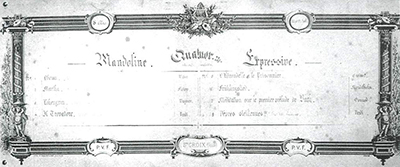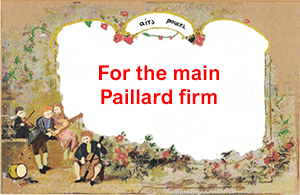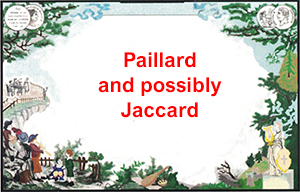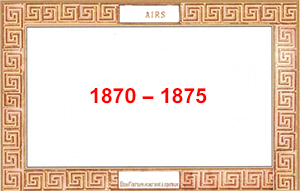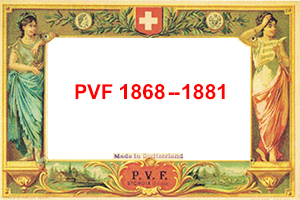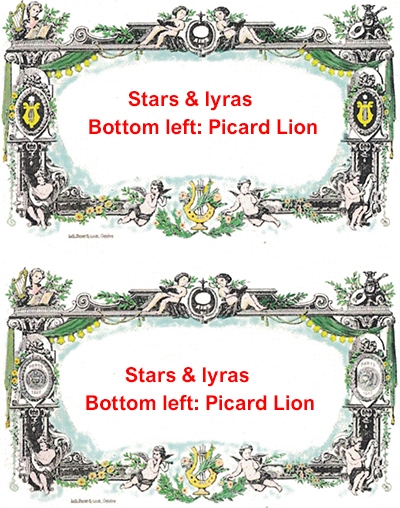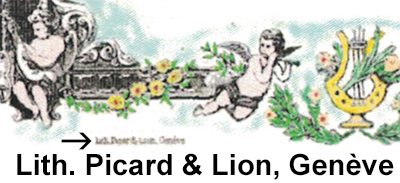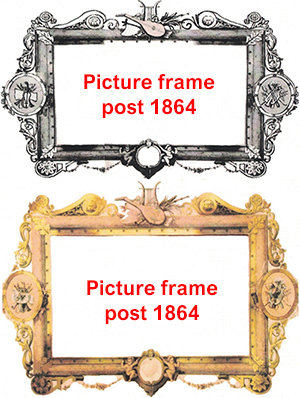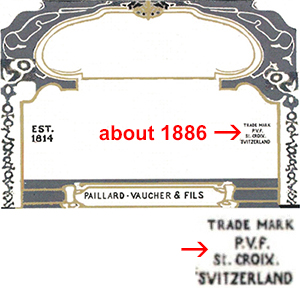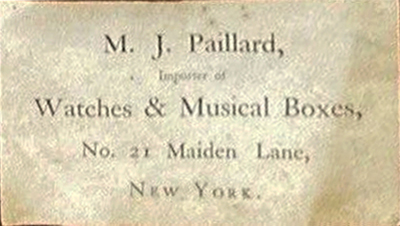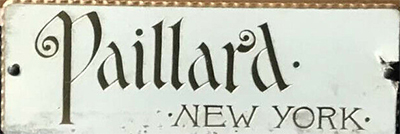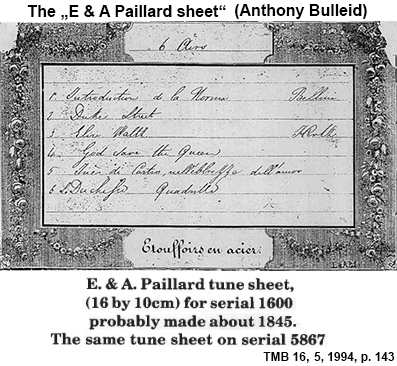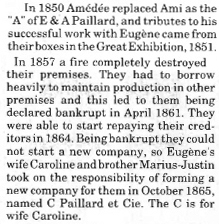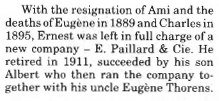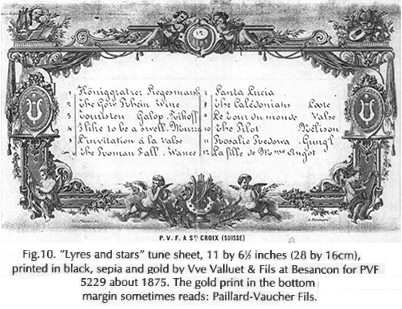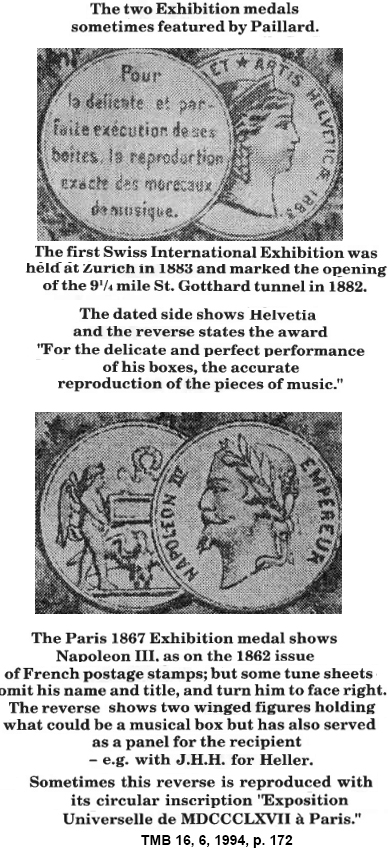|
Keywords: Introduction, Index, PICTURES, Sublime Harmonie, Most Important At A Glance The PAILLARDS From 1875 to 1905 Paillard was the most important and most productive music box manufacturer in Switzerland. The name Paillard is known on the five continents, not only for his music boxes, but also for gramophones, typewriters and movie cameras. Paillard reigned supreme over Sainte-Croix for nearly a century, because of the number of people it employed and the economic and political power it held, and because it encompassed nearly all aspects of life on the Jura heigths. Paillard left an indelible mark on the locality and erected the impressive buildings they erected in Rue de l´Industrie, most of which still exist today and are used for various purposes. Paillard was the most important company in the Sainte-Croix region, (second important: Mermod Frères), until the production was abandoned in 1985. (Piguet 2004, p. 276-285) For the details of the history of the two great Paillard firms please click here
General Index: Firms, Persons, music boxes, periods of time Antoine Paillard (clock maker) PICTURES of Movements of Paillard Überblick: Die diversen Paillards
Featured (main) chapters 8/3 ( Großformatige Paillard-Spieldosen Siehe das Kapitel Wichtigste Bildinformation rechts PVF Nr. 14067 (mit ungleich breiten Randbordüren, right bordure smaller than the left) The left and right side is the most important information / chapter 25 left and right Kleinformatige Paillard-Spieldosen Pocket size boxes mit „Half Bows Ornate“ on the music sheet ( Small size music boxes by Paillard ( Featured (or main) composers, Chapter 8/3
Featured (or main) composers, Chapter 10/1 10/1: •BelMoRFoWeFlot – VerSLabGSch•
Featured (or main) composers Chapter 10/4/1 ( Chapter 12/3 ( Chapter 20 (
10/4/1: •MoRoWeMeyerFlot-DonSLabGSch•
Drucker: Guyot
|
|||||||||||||||||||||||||||||||||||
~1828 (spätestens 1830)–1865 |
E. Paillard & Cie E. und C. Paillard |
Werknummern: 1851: ~5000 |
Verkauf in eigenen Geschäften in Paris und New York, Teilnahme an der Great Exhibition in London 1851, also der ersten Weltausstellung (siehe weiter unten). E[ugene] et A[mi] Paillard On 21st August 1848, the E. et A. Paillard company was founded in Sainte-Croix, taking over the activities of the previous company and opened a branch in Paris. ‘E’ stood for Eugène Paillard, and ‘A’ represented Ami, who was established in Paris and ensured distribution of their products in France. Marius-Justin Paillard
"A short while later, the fourth brother, Marius-Justin, settled in New York where he created M. J. Paillard & Co., Music box importers, which would later be taken over by one of his nephews." (Piguet 2004, p. 276-285) 1892: M. J. Paillard and Jacot had the same adress: 298 Broadway, New York Spielwerke von Marius-Justin Paillard / M. J. Paillard & Co. Alfred-Ernest Paillard. "In 1850, Amédée Paillard replaced his brother Ami, but neither the name nor the products changed. The scene was set for the Paillard brother´s success. (Piguet 2004, p. 276-285) Alfred Ernest Paillard. "Ste-Croix and 680 Broadway, New York. C. 1887. Musical-box makers who were sales agents for the Capital and Criterion musical boxes made by F. G. Otto as well as Paillard and Mermod Frères. During the 1890s they were sued by the years. Co-patentee with O. H. Arno oft he Arno musical box." (Ord-Hume, Music Box, 1980, p. 324) E[ugen] & A[mi], Brothers Paillard. Success was not long in coming. The Paillard brothers went to London in 1851 to the Grand Exhibition of Industrial Products of all Nations, to see how their products held up against the competition, in particular from Geneva. They presented a large music box called Mandolins and snuffboxes playing two and three tunes, in total four boxes at prices ranging between 35 and 165 francs. No awards were given for this first participation. At the Exposition universelle de 1855 at Paris, at a time when the music box industry in Sainte-Croix was struggling for recognition, the Paillard brothers (E. & A. Paillard) obtained an honorable mention for their watches and music boxes. The company prospered during those years and took on an apprentice clerk at the beginning of 1854 and in 1857, whereas the family purchased numerous plots of land and buildings in the village of Sainte-Croix. (Piguet 2004, p. 276-285) In 1857, a fierce fire completely destroyed the house [...] of the Paillard brothers, and this at a time when there were insufficient means to fight fires, taking into account the preponderant use of wood in construction. And to carry on their activities the following year, the Paillard brothers had to take out a first loan, followed by several more, however not enough to reverse an unfortunate tendency. With the result that on 3rd April 1861, they asked for suspension and on 5th April, the Tribunal of Grandson declared bankruptcy and then liquidation of assets, some of which were owned jointly by Jenny Paillard and Marius-Justin. In spite of their numerous possessions, the three houses, offices and workshops, there were liabilities amounting to 140,000 francs. (Laurent Tissot: E. Paillard & Cie. SA) (Piguet 2004, p. 276-285) |
||
C[aroline] Paillard & Cie
(Zu einer Liste der Frauen, die in der Geschichte der Kammspielwerke eine Rolle gespielt haben) Initials JA stamped on comb are a feature of some Paillard boxes. Not identified. See chapter JA. Zur Liste der der Medaillengewinner bei der Ausstellung in Philadelphia 1876 E. Paillard was awarded by a diploma for importance of display, brilliant workmanship, force and resonance of music box combs at the National Exhibition in Zürich 1883 |
Werknummern: |
|
|
"Paillard & Co., C. 62 Holborn Viaduct and, later, 28 Berners Street, Oxford Street, London, and 680 Broadway, New York. Patentee and manufacturers of the Amobean musical box with interchangeable cylinders. An advertisement dated October 1881 shows Paillard, Vaucher, Fils & Company at 62 Holborn Viaduct." (Ord-Hume, Music Box, 1980, p. 325) Eugène and Amédée Paillard undertook to reimburse their creditors who, on 11th March 1864, were advised that they could claim “a small dividend” at the liquidator´s offices. When the period of disgrace came to an end on 7th October 1865, a new company was created under the name C. Paillard & Co (‘C’ for Caroline Paillard-Gonthier, wife of Eugène Paillard), under the responsibility of Caroline and Marius-Justin Paillard. The objectives were “to manufacture and sell music boxes, watches, etc.”. In fact, these two people served as a “screen” for Eugène and Amédée who, on account of their bankruptcy, were not allowed to set up a new company but who could pursue their activities. (Piguet 2004, p. 276-285) The two brothers never stopped working and between 1850 and 1860, Amédée Paillard brought many improvements to the music boxes. He developed the principle of the interchangeable cylinder, which was introduced around 1850 and led to an impressive expansion of the market: the music box was no longer limited to playing the tunes for which it was designed, but the acquisition of additional cylinders, which could be removed and changed at will, gave access to other tunes. In the beginning, this innovation was not without problems, in particular on account of the relatively delicate cylinder replacement operations and the fragility of the cylinders, for a broken tooth or comb was enough to spoil the entire tune. (Piguet 2004, p. 276-285) Then Amédée developed a replacement system which faciliated these operations and limited the risk of accidents. He also designed a revolver music box, a principle which had probably been studied previously by other manufacturers – some sources quote Henri-Joseph Lecoultre, others Margot and Junod, some refer to Jérémie Recordon – but which Amédée completed and for which he filed a patent application in 1870. These boxes had a spring barrel, like for a revolver, which brought together from three to six cylinders playing several tunes each, and a rotation system presented them one after the other to the teeth of the comb. The advantage of these revolver boxes was that they allowed the customer to choose and to listen to a whole musical program without changing cylinders. However, the mechanism was relatively heavy and costly, with the result that the revolver boxes were produced in small quantities, soon replaced by the normal interchangeable format. (Piguet 2004, p. 276-285) Paillard, Amedee / Amédée, Ste. Croix, U. S. Patents: 105,972, Aug. 2, 1870 – assigned to M. L. Paillard & Sons, New York, N. Y.; 212,108, Feb. 11, 1879 – ditto. (Mosoriak p. 105) Charles Paillard, son of Amédée Paillard. Ste-Croix, 1875. 1874/75: "Invented device to increase volume of sound produced by a musical box without dissonance by the use of multiple combs." He "also contrived improvements to the `Sublime Harmonie´ type of combs in 1877, in conjunction with Louis Recordon-Sullinger of Ste-Croix." PICT: Music box by Charles Paillard & Co Amédée Paillard was assisted by his son Charles, to whom the music box industry is indebted for the invention of the Sublinme Harmonie, one of the most effective systems ever developed. It would recolutionize the art and subsequently be copied by all the manufacturers of large cylinder and disc-playing boxes. Charles Paillard applied for English patent No 3697, on 26th October 1874 in the name of W.R.Lake and for American patent No. 161,055 on 23th March 1875. (Piguet 2004, p. 276-285) As he explained his discovery: “Before my invention, to my knowledge, music boxes had only metallic sound. If one wanted to increase the volume of sound, one had to use more teeth and pins, which diminished the tone and increased the length of vibrations, with the resulting interference of vibrations and sound waves destroying harmony and producing dissonance.” (Piguet 2004, p. 276-285) “The objective of my invention is to correct these imperfections. It consists of combining a rotary musical cylinder, two or more combs with notes tuned in an identical or nearly identical manner. When tuning the teeth of the comb to the same tonality, I introduce a slight dissonance and the fact is that this dissonance – the teeth oft he same note being separated – give a more powerful and harmonious sound. If the box has to produce a more powerful and harmonious sound than the other boxes, all one needs to do is to have the same tune played by two or more combs, but if I want to hear the different shades of musical expression, such as piano, crescendo, forte, decrescendo, etc., I must play one or more combs simultaneously, depending on the effect I want to produce.” (Encyclopedia, p. 32) (Piguet 2004, p. 276-285) Paillard, Charles, Ste. Croix, U. S. Patent 161,055, Mar. 23, 1875. Co-patentee 369,258, Aug. 30, 1887 – assigned to M. J. Paillard & Company, New York City. (Mosoriak p. 105)
On the strength of these duly patented discoveries, accepted as such, and even though they might have been inspired by older realizations at a time when patens did not exist, thus making exhaustive historical research impossible, the Paillard brothers had better luck in the 1865s. Although they did not participate in the Exposition universelle in Paris in 1867, they nevertheless persisted in developing their art and produced some truly wonderful boxes. (Piguet 2004, p. 276-285) Quoting Ernest Paillard: “Snuffbox manufacture was rather primitive in the beginning; everything was made by hand, we sold a small music box for 120 francs which sells today (in 1917) for 8 or 10 francs. The horn boxes were replaced by the lacquer boxes, in metal or in wood, sculpted or with rich inlay, the number of tunes varied from two to eight, which replaced the gear by an endless screw wound by a handcrank. That is how the handcrank music box was created. It was applied to many toys, spinning-tops, etc. These different articles carried the name of Sainte-Croix to countries all over the world. ” (FAS 23rd May 1917) (Piguet 2004, p. 276-285) In 1869, Paillard employed five people in its workshops and great many more at home. The company produced 5,769 handcrank boxes, 18,762 small boxes and 1,189 cartels, with sales of 300,000 francs. In the slower periods, they made a multitude by the Leubas and the Bovets in Fleurier. In 1873, the turnover progressed to 450,000 francs and on 30th October 1874, Eugène and Amédee Paillard, having paid off their creditors, requested – and obtained – their rehabilitation by the district tribunal. (Piguet 2004, p. 276-285) From there on, things were very fast. “On 11th August 1875, Eugène and Amédée Paillard took over the goodwill of C. Paillard & Co given them by Caroline Paillard and Mathilde Paillard, the widow of Marius-Justin. They drew up a contract for a company with the same name, head office and objectives. In the same period, they left their comptoir, where a few workers assembled and controlled music boxes. They established themselves in a building acquired in 1872 in the Rue de l`Industrie and installed a music box factory, the first of its kind in Sainte-Croix, in which the progressively introduced the manufacture of complete music boxes.” (Tissot, p. 30) (Piguet 2004, p. 276-285) “Production in the C. Paillard & Co. factory started off modestly. At the beginning, the building on one single level housed eleven workers. Two years later, staff levels increased by only six units. From 1878 onwards, the company started a period of growth, which continued over the next decade.” (Piguet 2004, p. 276-285) “Two floors were added to the building in the Rue de l´Industrie, and in 1882, a second factory was erected, equipped with a steam engine, which increased production capacity. There was a significant increase in the number of workers, up to 100 in 1885.” (Tissot, p. 31) In 1887, Paillard produced 60,000 handcrank boxes, 25,000 small music boxes and 9,000 cartels, with total sales of 770,000 francs. (Piguet 2004, p. 276-285) In 1876, at the World Exhibition in Philadelphia, Paillard once again came up against the competition. “Messrs. Paillard & Cie. exhibit two splendid and expensive cabinet music boxes. In Sainte-Croix, everybody had the opportunity of seeing and listening to them. Amateurs of beautiful music and objects of good taste spent many an hour admiring these masterpieces which, in the music box world, presented important changes.” (Piguet 2004, p. 276-285) “The first of these pieces is a writing-desk decorated with inlay, in Greek style and most elegant. It is a complete orchestra with zither accompaniment, playing eight tunes selected from the most beautiful of operas. The cylinder measures 34 inches. The effect is delightful. According to the connoiseurs, it is a marvel of its type.” (Piguet 2004, p. 276-285) “The second piece, or Sublime Harmonie, is a magnificent cabinet in black polished mahogany and ivory, in the style of the middle ages. It represents a dining room dresser, but of a magic dining room. It is sumptuously decorated with brass and gold chiselled ornaments and with paintings on ceramic. It plays 36 tunes and has 6 interchangeable cylinders 20 inches long.” (Piguet 2004, p. 276-285) “The music of these two boxes, arranged by Mr. Bruschi, composer from Sainte-Croix, leaves nothing to be desired as far as fidelity of reproduction, harmony and purity of sound. The enchantment lingers on long after the instrument has stopped playing, the melody is still there, and one is carried away by its sweet harmony.” (FAS 23rd February 1876) (Piguet 2004, p. 276-285) At the end of the century, Paillard introduced numerous improvements to music box production and filed many patent applications, a sure sign of the steady development of the world market. After the revolver mechanism and the Sublime Harmonie principle, Amédée Paillard applied for an American patent on 11th Februara 1879 covering new mechanisms destined to facilitate the manipulation of interchangeable cylinders. In 1882, it was Ernest Paillard who invented new types of springs, spring barrels and speed governors, and in 1886, A. Paillard, together with Alfred Sueur, took out patents for a safety check which they invented, and for a zither system comprising a roll of thin tissue paper pressing down on the vibrating teeth, to produce a very mandolin-like sound. These techniques had been developed by Marel in 1878 and then perfected by the Paillards. Around 1880 in particular, Charles manufactured a six-tune movement with automatic zither, which was however not developed further. (Piguet 2004, p. 276-285) On 31st October, in Sainte-Croix, Arthur Jeanrenaud, filed a patent for the plérodienique system, which was immediately applied by Paillard. The author explained his invention as follows: “In music boxes, there is an interruption at the end of each cylinder revolution, on account of the gap between the tunes, which allows tune change without damaging the pins or the teeth, before presenting a different set of pins to the comb teeth. Such instruments can only play short sequences.” (Piguet 2004, p. 276-285) “The improvement I have introduced allow music boxes whose tunes require two or more cylinder revolutions to play continuously, in a practical manner.” (Piguet 2004, p. 276-285) “It is enough to prepare two identical cylinders and to place them one next to the other on the bedplate, facing the teeth of the comb, each cylinder having an independent tune change system and the longitudinal empty spaces on each cylinder being positioned in different places. In this way the music plays without interruption whereas the two cylinders change places alternately to present a new pinned section before the respective teeth.” (Encyclopedia, p. 42) (Piguet 2004, p. 276-285) Although this principle had already been used, for example to build orchestrions, it was applied for the first time to cylinder boxes and allowed longer musical works to be performed. This had not been the case before. (Piguet 2004, p. 276-285) On 30th August 1887, Charles Paillard and Louis Recordon-Sulliger filed a patent destined to further enhance the performance of the Sublime Harmonie and to give it a stronger resonance, without creating strident notes. It was a V-shaped comb (which had already been used elsewhere in the early music box years, without having been patented). “The object of my invention is to have a comb with two teeth or more with the same tone or with a slight dissonance, the teeth being sufficiently separated one from the other to prevent all sound interference. The invention consists of a comb on which the teeth become shorter and increase in tone from the extremities towards the center.” (Encyclopedia p. 32) (Piguet 2004, p. 276-285) Duplex. Paillard also manufactured the Duplex music boxes invented by Alfred Junod which allowed enhanced resonance by the simultaneous use of two combs opposite two cylinders playing simultaneously. In the music box industry, Paillard was the most technologically advanced of all manufacturers, and its leaders of the company and of the region. In 187, the Paillard family was very active within the Société industrielle et commerciale, on which it was able to exert a certain influence for dozens of years. In 1876 and 1877, Eugène Paillard was earmarked to use all his influence in favor of the renewal of the trade agreement with France, the objective of which was to obtain the lowest possible import duties on music boxes. In 1880, he gradually entrusted his commercial responsibilities to his son Ernest, who had studied at the Stuttgart School of Commerce from 1866 to 1867. Ernest Paillard performed brilliantly, not only within the Société industrielle et commerciale but also in the army, where he became lieutenant-colonel in 1891, as well as within the framework of political institutions. […](Piguet 2004, p. 276-285) Frühe Werknummen stammen also aus der Zeit vor oder um 1830 (Erste Nummerierung) und ab 1875 (Zweite Nummerierung) |
||
Im Jahr 1869 betrug die Produktion 1000 Cartel-Werke, 6000 Manivellen und 18000 Tabatièren 1875: Bau einer neuen Fabrik (und gleichzeitig Neubeginn der Zählung der Werknummern) In den Jahren 1882 bis etwa 1885 fand die Übernahme des Londoner Geschäftes „P. V. F.“ statt (Bulleid). 1893: Rückgang der Jahresproduktion |
||
1882–1885 |
Übernahme des Londoner Geschäftes
|
Alle späteren Werke von „P. V. F.“ |
~1895–1914 |
E. Paillard & Cie |
Höchste Werknummer: 122.111 (Bulleid) |
E. Paillard Ernest Paillard, Ste. Croix, U. S. Patents: 268,272, Nov. 20, 1882 – assigned to M. J. Paillard & Co., New York, N. Y. (Germany, 27,520, July 11, 1881); 268,273, Nov. 20, 1882. Between 1880 and 1900, changes were introduced in the management structure of Paillard. These were in fact transitions from one generation to another, and from one department to another. After the generation of Moise Paillard and then Samuel, Eugène and Amédée, it was Charles and Ernest who would hold the reins of the company. Amédée Paillard died on 25th February 1880, and his son Charles replaced him in a new company created on 2nd March 1880, involving Eugène and his son Ernest, Charles and his brother Ami. Ownership of the company was divided in equal parts between the two families of Eugène and the late Amédée, but the withdrawal of Ami Paillard, the death of Eugène on 30th March 1889 and of Charles Paillard on 11th October 1895, would leave Ernest alone as head of the company. A new company was set up, under the name E. Paillard & Cie. and in 1899 Ernest bought out the share of their heirs of his cousin Charles (whose family settled in Vevey) for 55,000 francs. He became the one and only owner and director of the company. From 1880 to 1890, Paillard continued to prosper, which reflected positively on the whole region and contributed towards peaceful understanding between employers and employees. At the time, when paid vacation did not exist, the Paillard and Thorens factories organized staff training courses, which consolidated employer/employee cooperation and promoted mutual respect, all the more so as the railway was still in the development stage and people commuted on foot or rode carts. […] Ernest Paillard Ernest Paillard & Cie From snuffboxes to large cartels Paillard participated in the Exposition universelle in Paris in 1889, together with Gueissaz Fils and one of its workers, Louis Gagnaux, who has been selected by his colleagues to represent them in the City of Light. Thereafter, the foremost music box manufacturer could be found at the majority of exhibitions, e.g. in Yverdon in 1894 and in Geneva in 1896, where the company rivaled Mermod Frères in exhibiting its impressive range of music boxes. (Piguet 2004, p. 276-285) Paillard, Alfred E., (citizen of Switzerland), New York, N. Y. U. S. co-patentee 526,499, Sept. 25, 1894 – assigned to M. J. Paillard & company, New York City. (Mosoriak p. 105) By way of illustrating the product range, here is a description of the Paillard stand in Yverdon: “2. Small handcrank movements in boxes made of thuya-wood, rosewood, etc., with bouquet, clip or painting; fancy musical articles such as decanters, tankards, plates, cigar holders, glove boxes, jewel boxes, albums, chalets, etc.”; “3. Large music boxes from 26 to 800 francs, piccolo or Sublime Harmonie, with or without the accompaniment of drums, bells, castanets and puppets.” “4. Boxes in the shape of a dresser, with visible bells and two dancing dolls, oak cabinet with table enclosing a musical movement with interchangeable cylinder, invented by the company.” (Nouvellliste vaudois, 6th February 1895) This shows that Paillard offered products which had a reputation for solidity and musical quality, in a range capable of satisfying all types of customers, from the man in the street to the Emperor of China. (Piguet 2004, p. 276-285) Paillard also made boxes of prestige, on special order. In Ernest Paillards words: “All the famous American millionaires possessed a music box. One day Miss Astor ordered from one of the factories in Sainte-Croix a music box with eigtheen cylinders of six tunes each (108 tunes), and the chinese Embassy in Washington ordered two large boxes with 108 tunes for the Empress of China´s birthday.” (FAS 23rd May 1917) (Piguet 2004, p. 276-285) In Geneva, Paillard exhibitied some of its mose beautiful pieces, one of which was built according to the plériodienique system, a musical chalet, quatuor-piccolo-zither boxes, an Excelsior box playing for about ten to fifteen minutes without rewinding, as well as other types of sublime harmonies. They won a gold medal. However, the world economic crisis of 1880-1900, aggraveted by the German disc boxes which were capable of playing more tunes at a lower price, thanks to their interchangeable discs, had an adverse effect on the company and on all the others as well. With a view to manufacturing disc-playing boxes, Ernest Paillard decided to go into partnership with the American engineer Georges Varrelmann who joined E. Paillard & Cie. on 1st Novemeber 1899. The company objectives were modified to “manufacture all types of music boxes and phonographs”. Several patent applications were filed and at the Exposition universelle of Paris in 1900, Paillard for the very first time exhibited phonographs as well as disc boxes, with a special characteristic. […] The following year, at the Exhibition in Vevey, Paillard was awarded another gold medal, with the congratulation oft he jury, and was the only manufacturer participating in Liège (Belgium) in 1905. The three major local manufacturers, Paillard, Hermann Thorens and Mermod Frères, employing a total of 328 people (nearly sixty percent on the shopfloor) and a even larger number at home, participated in the exhibition in Milan in 1906. On this occasion, Hermann Thorens, jury chairman, wrote of his relative, competitor and neighbor E. Paillard & Cie. that he had “a very beautiful and comprehensive exhibit, covering the manufacture of music boxes, cylinder and disc phonographs, and mechanical disc pianos which he is the only one in Switzerland to make”. (Official report of the World Exhibition in Milan) (Piguet 2004, p. 276-285) These few word summed up in a nutshell the philosophy of Ernest Paillard and the evolution he imprinted on his company. He was convinced that Edison´s invention of the phonograph in 1877 and the subsequent arrival of the disc-playing boxes in 1886 would bring improvements which, once implemented – which was unavoidable – would mean merciless competition for the traditional cylinder boxes, no matter how many subtle improvements were added. After 1897, he envisaged the production of ecophones, then phonographs and mechanical pianos, all instruments whose development was most painful for manufacturers who were inadequately equipped or who did not have sufficient financial resources to adapt. (Piguet 2004, p. 276-285) Diversifications In this enumeration, the cylinder and disc music boxes took up less and less space. Paillard still presented some music boxes at the Fair in Lausanne in 1916 and 1917, and the following year they were still looking for a few women pin straigtheners, but in 1920, when the factory in Yverdon opened up, a page had been turned and music boxes abandoned. (Piguet 2004, p. 276-285) In 1911, Ernest Paillard was not at allwell and his son Albert (fifth generation) took over from him, managing the company with his uncle Eugène Thorens. The following year, Georges Varrelmann, the American, retired. Shortly after the war, the shortage of accomodation in Sainte-Croix and the lack on manpower led Paillard to purchase building sites in Yverdon. Ernest Paillard passed away on 30th December 1922 at the age of seventy-one. (Piguet 2004, p. 276-285) For about thirty years, from 1875 to 1905, Paillard was the most important music box manufacturer in Switzerland and in the following decades, the company was to occupy a leading position in office machinery, especially with its universally recognized portable Hermès typewriters, its radios and Boles movie cameras. (Piguet 2004, p. 276-285) 1914: Beare & Son, a the musical instrument wholesaler, was importer of Paillard musical boxes. |
||
1900: Starker Rückgang der Jahresproduktion Die Nummerierung der Cartel-Werke dürfte (laut einer vorsichtigen Einschätzung von Bulleid) die Manivellen und Tabatieren nicht einbezogen haben. |
||
(Bulleid 3rd Suppl., Chart 12, p. 59)

At At a glance: The Paillard firms

At a glance: 3 names if the firms, and 2+3+2 ownerships
1874: Sublime Harmonie, the most important invention by C. Paillard
The other family firm was Paillard-Vaucher et fils headed by Auguste Paillard-Vaucher.
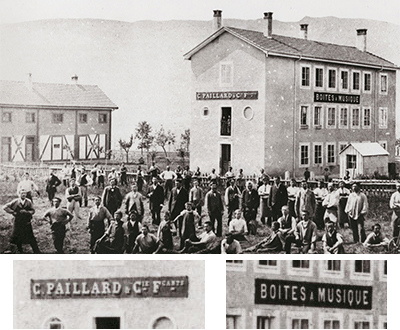

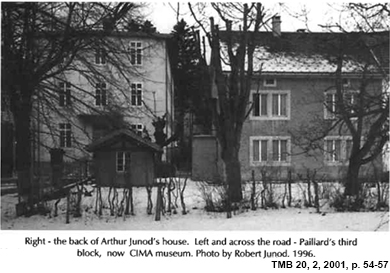

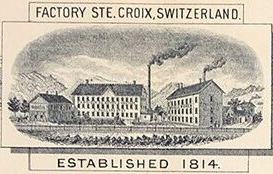
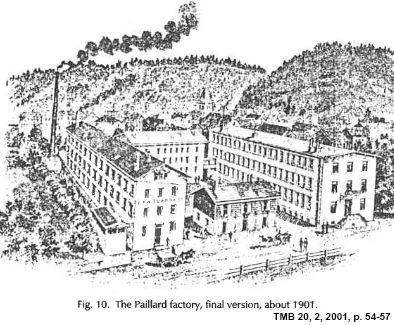
Zum Drucker von Musiktafeln names Bognar jeune, der auch für PVF gearbeitet hat und in diesem Zusammenhang nicht ausser Acht gelassen werden sollte
PVF 11957: Zwei Musiktafeln (!)

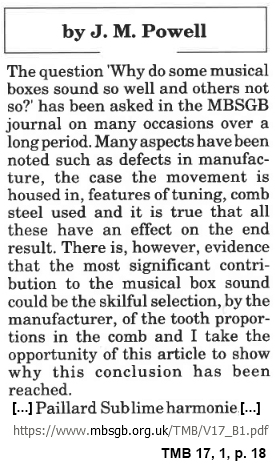
Normalerweise zitiert man aus einem Aufsatz die wichtgsten Passagen. In diesem Fall sei hier nur die Einleitung wiedergegeben, denn wie J. M. Powell sein Herz an eine Paillard Sublime Harmonie verlor; und wie er das beschreibt, ist ein Vergnügen der besonderen Art. Ein Nachlesen des Originalaufsatzes lohnt sich! (Otmar Seemann)
Kurzer Überblick über die Geschichte der Firmen,
in deren Namen Paillard vorkommt
Warnung: Die Datenfülle ist so groß, dass es einige Zeit braucht, bis man das Wichtigste verinnerlicht und einen Überblick gewonnen hat!
Die in den beiden Spalten erwähnten Firmen waren zeitweise Gegner und manchmal auch zusammenarbeitende Partner!
Erster Tipp: Immer wieder mal reinschauen!
Zweiter Tipp: Nicht verzagen, da trotz der bewundernswerten Vorarbeit der weiter unten zitierten Autoren immer noch Wissenslücken vorhanden sind, die noch gefüllt werden sollten.
1814: Gründung einer Uhrmachererkstätte durch Moïse Paillard
1824: Interesse an Spielwerken ab 1824
1830: Moïse Paillard stirbt 77-jährig
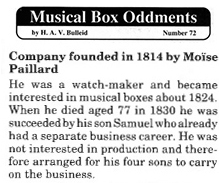
1830: Die vier Söhne von Moïse Paillard führen das Geschäft weiter
1848: Eugène P.: Leiter der Produktion
Zu einem Sticker auf der Unterseite einer Spieldose
Zum Spielwerk Nr. 52231 der Firma Paillard New York 1883 – 1886: Louis Gustave Jaccard was working in the form of Marius Justin Paillard. In New York wurden auch „Schweizer Plattenspielwerke“ verkauft. Zwei Bedeutungen für die folgende Abkürzung
|
 |
Zu einer grösserformatigen Abbildung des Porträts von Ernest Paillard siehe weiter unten |
1830: Auguste Paillard-Vaucher als Spielwerkmacher tätig
1852: Gründung des Unternehmens Auguste Paillard-Vaucher (PV)
1865 bzw. 1867 (?): Gründung des Unternehmens Auguste Paillard-Vaucher et fils (PVF)
![]()


1867: Bronzemedaille bei der Pariser Weltausstellung
1881: Finanzielle Schwierigkeiten (mit vermutlich geringer Produktion)
März 1885:
Bankrott der Firma PVF in St. Croix
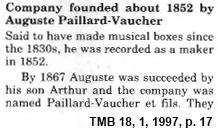


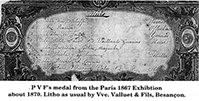


März 1885: Bankrott der Firma PVF in St. Croix, schon 1883 nahm die Firma Auguste Paillard-Cuendet Tätigkeit auf, die bis 1895 existierte
Bellamy, Music Makers of Switzerland, (2015), p. 6
1875–1881: Gründung und Schliessung des Unternehmens Auguste Paillard-Cuendet
Bellamy, Music Makers of Switzerland, (2015), p. 6
1883–1895: Wiederaufnahme der Geschäftstätigkeit von Auguste Paillard-Cuendet und Schließung der Firma wegen Ablebens im Jahr 1895

Weltausstellung in Paris 1889
Die Firma Paillard & Cie war Teilnehmerin und Silber-Medaillen-Gewinnerin bei der Pariser Weltausstellung von 1889 (bei der der Eiffelturm vorgestellt wurde und auch der Edison-Phonograph)
Auguste Paillard-Vaucher. At the beginning of the 1830, the Paillard-Vaucher company was known in the Sainte-Croix region for its music box production.
Like most of the other établisseurs, Auguste Paillard-Vaucher supplemented the activities of his comptoir with a shop, for in 1852 he defined himself as a “manufacturer and trader in music boxes, draper and grocer”. (ACV Almanac) […]
In 1862, Auguste Paillard-Vaucher was a signatory to the appeal addressed to the Swiss authorities regarding the Trade Agreement with France over which a lot of ink would be spilt in the years to come. He was therefore one of the pillars of the Société industrielle et commerciale of Sainte-Croix.
Exposition universelle in Paris 1867
In 1867, Paillard-Vaucher et Fils (Arthur Paillard would suceed his father Auguste) were at the Exposition universelle in Paris, where they obtained a bronze medal for the large cylinder boxes. The company in fact was at the pinnacle of its glory in the golden years of the large music boxes.
They made a music box with a two-part comb called Quatuor Mandolin Expressive which played eight ouvertures, such as Oberon, Martha, Lohengrin and Il Trovatore.
“Paillard-Vaucher & Fils introduced the prototype zither in an attempt to offer an even wider tonal variety to a single-cylinder musical box than had hitherto been possible. This was a late-style, crank-wood box with the motor on the right-hand side of the case. The 13.5-inch cylinder played six airs on two combs, basically sublime harmonie in style. However, the tunes were arranged in very different manners, two being sublime harmonie, two as piccolo zither and the final pair being tremolo zither. Neither of the latter two styles was particularly effective but it was a most interesting concept. Only one box has been seen and it is considered rare.” (Ord-Hume p. 151)
In 1885, Paillard-Vaucher also made boxes in the plériodienique style in which two cylinders were arranged along a common axis and played nonstop, each cylinder changing while the other continues to play. They were of course large-size boxes (forty-two centimeters long) which were placed on a table containing drawers to store the nine accompanying cylinders. Two boxes representative of this style can be found in the National Museum in Utrecht and the Murthogh Guinness collection in New York.
Nonetheless, the company did run into difficulty. On 7th April 1881, Auguste Paillard-Jaccard in Sainte-Croix, and his son Arthur Paillard in London, filed for bankruptcy. The procedure was however suspended, and the liquidator convened all the creditors to the Hôtel d´Espagne in order to adopt measures likely to meet the requirements of all conncerned. On 10th October, there were offered for sale by public auction in Sainte-Croix “objects relating to watchmaking and music boxes such as 3 small organs, about 400 music boxes in mahogany, rosewood, thuya-wood, maple, horn, etc., 1 table with rich inlay, including checkerboards, chess board and ivory chess set all of which contain a musical movements etc.”
In London, where Paillard-Vaucher als had an office for sales and after-sales, run by Arthur Russell, an auction was held, which brought in 88,474 francs for the watches and 53,645 francs for the music boxes, resulting in an increase of 23,000 francs in the prices indicated in the inventory of April 1881. In Sainte-Croix, 4,800 francs worth of watches, 840 francs of boxes and 10,000 francs of miscellaneous objects were sold.
On 21st March 1885, Paillard-Vaucher & Co. closed down in Sainte-Croix. (Piguet 2004, S. 285-296)
Ein Teil der Schweizer Käufer, die bei ihren Landsleuten Spieldosen kauften, waren ihrerseits selber Spielwerkhersteller, die dringende Kundenwünsche aus dem Bestand der eigenen Produktion nicht bedienen konnten (Alfred Chappuis, 1955). So half einmal Geo Baker der Firma L'Épée aus, dann bezog Geo Baker seinerseits von PVF und von anderen nicht namentlich genannten Firmen, und auch die renommierte Firma Nicole musste einige 50.000-Werke bei PVF beziehen und musste, damit diese damit sie nicht auffallen, entsprechend adaptieren und „auf Nicole umfrisieren“.
Charles Paillard (um 1870):
Mystery tune sheet (?)
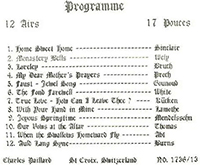
Zu einer grösseren Auflösung (einer neuzeitlichen Neuanfertigung?) bitte klicken
![]()

Paillard boxes
According to Bulleid, Technology, p. 79 (table 7, abridges)
Serial / year
599 1876
692 1873
1617 1862
2260 1878
2699 1872
5395 1879
5554 1874
5794 1875
7676 1881
8737 1883
10299 Sept. 1873
12588 1879
16783 Sept. 1882
24563 1883
35172 1884
45296 1885
56891 1887
79789 1889
96079 1893
96998 1888
May 1895: Introduction of CAPITALS
Please, click here
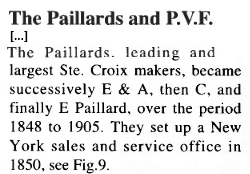
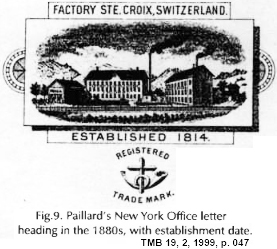
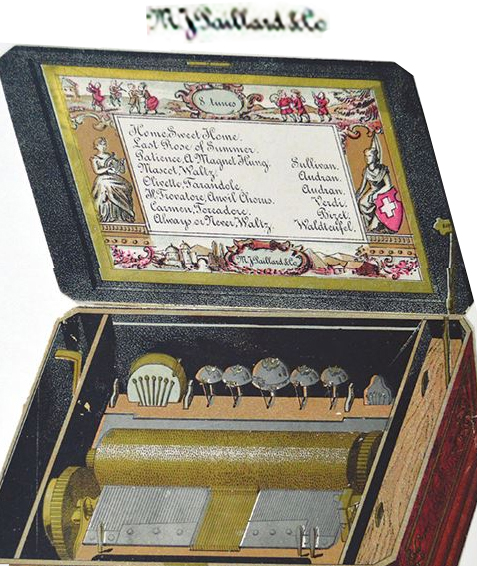
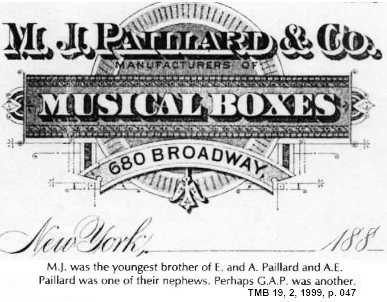
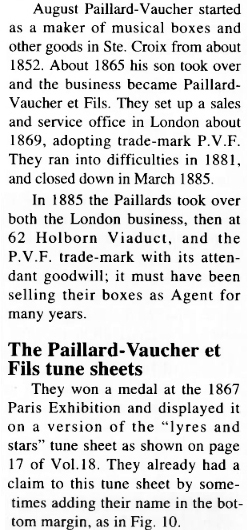
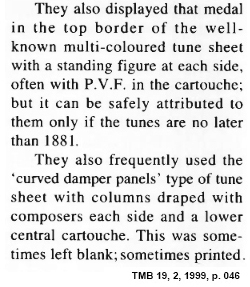
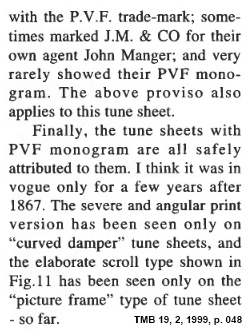
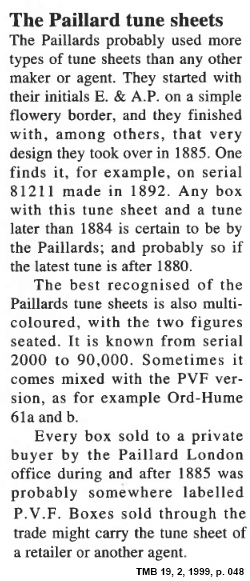
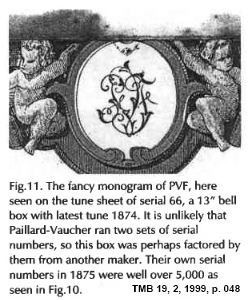
Zu der nach Junods Vorbild konstruierten Paillard-Columbia
C. Paillard or PVF?
Rather C. Paillard
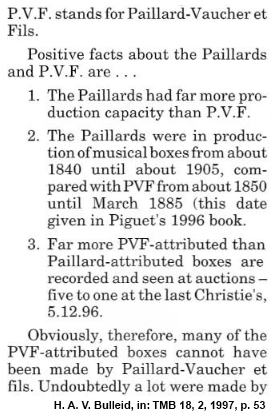
Bitte um Beachtung (1): Bulleid fand keine keine Musiktafel vor 1867
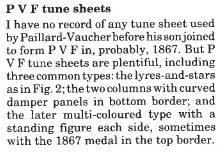 Fig. 2=
Fig. 2=
Das Diplom bei der Ausstellung von Zürich im Jahr 1883 wurde an C. Paillard & Cie verliehen (und nicht an PVF)


Bitte um Beachtung (3): Das C in der Firmenbezeichnung C. Paillard et Compagnie steht für Caroline


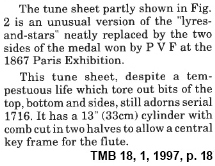
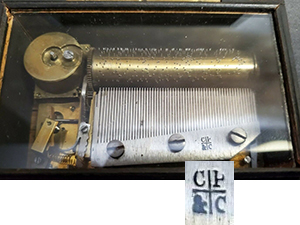
Siehe auch die Spieldose Q 9842
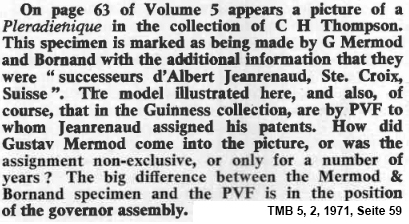
C[aroline] Paillard erhielt die Medaille, nicht PVF!

Weltausstellung in Mailand 1906
Hermann Thorens' report explained the rapid evolution of the sound reproduction instrument market and the way the three most important manufacturers of Sainte-Croix – Paillard, Mermod Frères and Thorens – adapted themselves to the market. (Le Pays horloger).” (Piguet 2004, p. 297-306)

Ernest Paillard, 1812-1895 (Chapuis, Alfred, Abb. 179, S. 194), firmenchef von 1895 bis 1914
Walzenwechsel = change of cylinder
Für den Wechsel der Walzen (interchangeable cylinders) gab es manchmal Gebrauchsanweisungen wie diese:

![]()
![]()
Kleinformatige Paillard-Spieldosen

Spielwerk mit drei austauschbaren Walzen (interchangeable cylinders) mit dem Design wie abgebildet
Nr. 1204 (Paillard); Nr. 1424 (PVF); Q 1547; Q 9842 (Paillard); Posthorn-Dagger-Zeichen (1); Posthorn-Dagger-Zeichen (2, rechts unten drei blaue Blüten); Kleine Musikdose; Kleinformatiges Werk monogrammiert CP, Nr. 12165; Kleinstformate (![]() )
)
Warnung
Die Datenfülle ist so groß, dass es einige Zeit braucht, bis man das Wichtigste verinnerlicht und einen Überblick gewonnen hat!
Die in den beiden Spalten erwähnten Firmen waren teilweise Gegner und keinesfalls immer zusammenarbeitenden Partner!
Immer wieder mal reinschauen! Es ist unmöglich sich alles beim ersten Mal merken.
Überblick: Die diversen Paillards
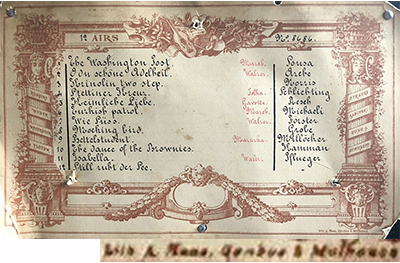
![]() Spielwerke der Firma Paillard:
692,
8235,
8686,
unnummeriert,
unnummeriert,
unnummeriert,
28901,
30239,
45310,
51111,
52157,
53702,
52157,
53702,
unnummeriert,
unnummeriert
Spielwerke der Firma Paillard:
692,
8235,
8686,
unnummeriert,
unnummeriert,
unnummeriert,
28901,
30239,
45310,
51111,
52157,
53702,
52157,
53702,
unnummeriert,
unnummeriert
[Paillard-Vaucher ?]Nr. 15657
(![]() +
+![]() +
+![]() )
)
10/4/1: •MoRoWeMeyerFlot-DonSLabGSch•


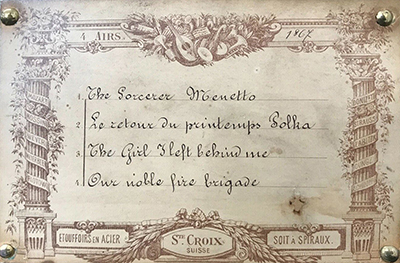
![]() +
+![]() +
+![]() Spielwerke (bitte durchklicken)
Spielwerke (bitte durchklicken)
20: •BelMoRoWeHändHayMendelBeetMeyerFlot – VerDonSLabGSchHalAubBalfeJullien•

![]() Spielwerk: 7805
Spielwerk: 7805
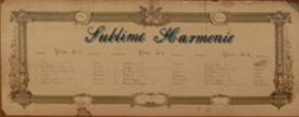
![]() Spielwerk: 19299
Spielwerk: 19299
Überwiegend oder exklusiv verwendete Musiktafeln

Ein Spielwerk mit drei austauschbaren Walzen (interchangeable cylinders) mit diesem Design
Picture Frame Design (Bilderrahmen-Design): ![]() music boxes
music boxes
Überblick: Die Paillards
~1828–65 |
E. und C. Paillard |
Werknummern: 1851: ~5000 |
Verkauf in eigenen Geschäften in Paris und New York, Teilnahme an der Great Exhibition in London 1851, also der ersten Weltausstellung. |
||
C[aroline] Paillard & Cie
(Zu einer Liste der Frauen, die in der Geschichte der Kammspielwerke eine Rolle gespielt haben) Zu einer Liste der der Medaillengewinner bei der Ausstellung in Philadelphia 1876 Teilnehmer bei der Nationalen Ausstellung in Zürich 1883 |
Werknummern: |
|
| Frühe Werknummen stammen also aus der Zeit vor oder um 1830 (Erste Nummerierung) und ab 1875 (Zweite Nummerierung) | ||
Im Jahr 1869 betrug die Produktion 1000 Cartel-Werke, 6000 Manivellen und 18000 Tabatièren 1875: Bau einer neuen Fabrik (und gleichzeitig Neubeginn der Zählung der Werknummern) In den Jahren 1882 bis etwa 1885 fand die Übernahme des Londoner Geschäftes „P. V. F.“ statt (Bulleid). 1893: Rückgang der Jahresproduktion |
||
1882–1885 |
Übernahme des Londoner Geschäftes
|
Alle späteren Werke von „P. V. F.“ |
~1895–1914 |
E. Paillard & Cie |
Höchste Werknummer: 122.111 (Bulleid) |
1900: Starker Rückgang der Jahresproduktion |
||
Die Nummerierung der Cartel-Werke dürfte (laut einer vorsichtigen Einschätzung von Bulleid) die Manivellen und Tabatieren nicht einbezogen haben. |
||
(Bulleid 3rd Suppl., Chart 12, p. 59)



1882: C. Paillard et Cie

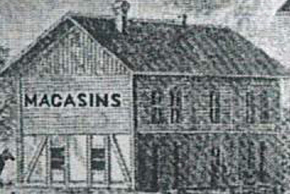


Bellamy: Tuneheets Makers Agents (2022), p. 18/6
~1900: E. Paillard

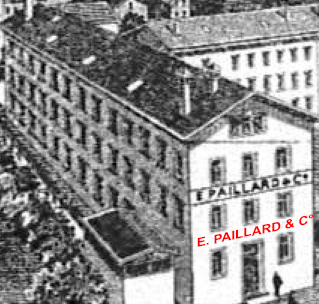
Bellamy: Tuneheets Makers Agents (2022), p. 18/2
Zum Drucker von Musiktafeln names Bognar jeune, der auch für PVF gearbeitet hat und in diesem Zusammenhang nicht ausser Acht gelassen werden sollte
PVF 11957: Zwei Musiktafeln (!)


Normalerweise zitiert man aus einem Aufsatz die wichtgsten Passagen. In diesem Fall sei hier nur die Einleitung wiedergegeben, denn wie J. M. Powell sein Herz an eine Paillard Sublime Harmonie verlor; und wie er das beschreibt, ist ein Vergnügen der besonderen Art. Ein Nachlesen des Originalaufsatzes lohnt sich! (Otmar Seemann)
Kurzer Überblick über die Geschichte der Firmen,
in deren Namen Paillard vorkommt
Warnung: Die Datenfülle ist so groß, dass es einige Zeit braucht, bis man das Wichtigste verinnerlicht und einen Überblick gewonnen hat!
Die in den beiden Spalten erwähnten Firmen waren Gegner und keine zusammenarbeitenden Partner!
Erster Tipp: Immer wieder mal reinschauen!
Zweiter Tipp: Nicht verzagen, da trotz der bewundernswerten Vorarbeit der weiter unten zitierten Autoren immer noch Wissenslücken vorhanden sind, die noch gefüllt werden sollten.
1814: Gründung einer Uhrmachererkstätte durch Moïse Paillard
1824: Interesse an Spielwerken ab 1824
1830: Moïse Paillard stirbt 77-jährig

1830: Die vier Söhne von Moïse Paillard führen das Geschäft weiter
1848: Eugène P.: Leiter der Produktion
Zu einem Sticker auf der Unterseite einer Spieldose
Zum Spielwerk Nr. 52231 der Firma Paillard New York Zwei Bedeutungen für die folgende Abkürzung
|
 |
Zu einer grösserformatigen Abbildung des Porträts von Ernest Paillard siehe weiter unten |
1830: Auguste Paillard-Vaucher als Spielwerkmacher tätig
1852: Gründung des Unternehmens Auguste Paillard-Vaucher (PV)
1865 bzw. 1867 (?): Gründung des Unternehmens Auguste Paillard-Vaucher et fils (PVF)
![]()


1867: Bronzemedaille bei der Pariser Weltausstellung
1881: Finanzielle Schwierigkeiten (mit vermutlich geringer Produktion)
März 1885:
Bankrott der Firma PVF in St. Croix






März 1885: Bankrott der Firma PVF in St. Croix, schon 1883 nahm die Firma Auguste-Paillard-Cuendet Tätigkeit auf.
Um 1870–1881: Gründung und Schliessung des Unternehmens Auguste Paillard-Cuendet
1883–1895: Wiederaufnahme der Geschäftstätigkeit von Auguste Paillard-Cuendet und Schließung der Firma wegen Ablebens im Jahr 1895

Weltausstellung in Paris 1889
Die Firma Paillard & Cie war Teilnehmerin und Silber-Medaillen-Gewinnerin bei der Pariser Weltausstellung von 1889 (bei der der Eiffelturm vorgestellt wurde und auch der Edison-Phonograph)
Ein Teil der Schweizer Käufer, die bei ihren Landsleuten Spieldosen kauften, waren ihrerseits selber Spielwerkhersteller, die dringende Kundenwünsche aus dem Bestand der eigenen Produktion nicht bedienen konnten (Alfred Chappuis, 1955). So half einmal Geo Baker der Firma L'Épée aus, dann bezog Geo Baker seinerseits von PVF und von anderen nicht namentlich genannten Firmen, und auch die renommierte Firma Nicole musste einige 50.000-Werke bei PVF beziehen und musste, damit diese damit sie nicht auffallen, entsprechend adaptieren und „auf Nicole umfrisieren“.
Charles Paillard (um 1870):
Mystery tune sheet (?)

Zu einer grösseren Auflösung (einer neuzeitlichen Neuanfertigung?) bitte klicken
![]()










In 1963, Paillard took over Thorens, which was at the time still producing music boxes. But Paillard was only interested in premises and staff, so they sold the music box part to Jean-Paul Thorens, who continued production with Mélodies SA. (Piguet 2004, p. 276-285)
Teilnehmer an der Uhrenmesse Basel 1946



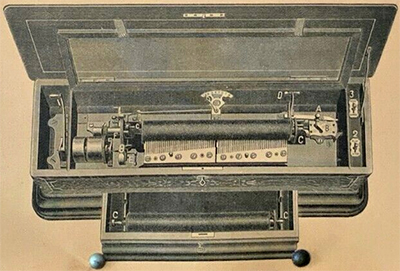
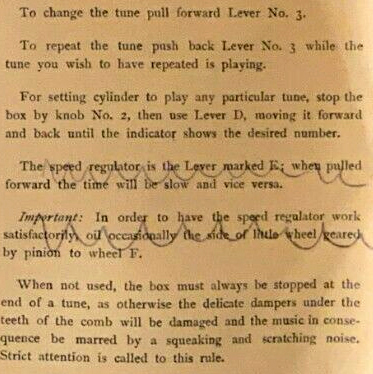
C. Paillard oder PVF?
Eher C. Paillard weil ...

Bitte um Beachtung (1): Bulleid fand keine keine Musiktafel vor 1867
 Fig. 2=
Fig. 2=
Bitte um Beachtung (2): Die Medaille wurde an C. Paillard & Cie verliehen
und nicht an PVF


Bitte um Beachtung (3): Das C in der Firmenbezeichnung C. Paillard et Compagnie steht für Caroline




Siehe auch die Spieldose Q 9842

C[aroline] Paillard erhielt die Medaille, nicht PVF!


Ernest Paillard, 1812-1895 (Chapuis, Alfred, Abb. 179, S. 194), firmenchef von 1895 bis 1914
Walzenwechsel = change of cylinder
Für den Wechsel der Walzen (interchangeable cylinders) gab es manchmal Gebrauchsanweisungen wie diese:

Kleinformatige Spieldosen
Nr. 1204 (Paillard); Nr. 1424 (PVF); Q 1547; Q 9842 (Paillard); Posthorn-Dagger-Zeichen; Kleine Musikdose; Kleinformatiges Werk monogrammiert CP, Nr. 12165; Kleinstformate (![]() )
)
Warnung
Die Datenfülle ist so groß, dass es einige Zeit braucht, bis man das Wichtigste verinnerlicht und einen Überblick gewonnen hat!
Die in den beiden Spalten erwähnten Firmen waren teilweise Gegner und keinesfalls immer zusammenarbeitenden Partner!
Erster Tipp: Immer wieder mal reinschauen! Es ist unmöglich sich alles beim ersten Mal merken.
Zweiter Tipp: Nicht verzagen, da trotz der bewundernswerten Vorarbeit der weiter unten zitierten Autoren immer noch Wissenslücken vorhanden sind, die noch gefüllt werden sollten.
Dritter Tipp: So manches ungemarkte Schlüsselaufzug-Spielwerk ohne Musiktafel und ohne jegliche Einstempelungen könnte eine Spieldose der Paillards sein. Bitte sehen Sie Ihre ungemarkte Trouvaille auch unter diesem Aspekt!

